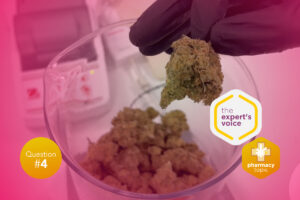ABSTRACT
Standardized compositions are vital for medicines, especially in the case of phytopharmaceuticals like cannabis. Precise control of cultivation conditions is crucial as the composition of cannabis, including cannabinoids and terpenes, determines its medicinal properties. Even slight changes can significantly impact therapeutic potential hence, rigorous quality control is essential to ensure reliability. These meticulous measures coupled with cloning during the cultivation process help to guarantee the production of a uniform, reliable and consistent phytopharmaceutical end product.
Standardization and quality control
An essential requirement for medicines is a standardized composition, as it prevents unexpected surprises regarding effects, guarantees efficacy and ensures purity. For a phytopharmaceutical, such as cannabis, this consists of strict control and monitoring of the conditions in which plants are grown. Cannabis varieties differ in their specific content of cannabinoids and terpenes and the exact combination of these active components in the final product determines its medicinal effect. This means that even relatively small changes in the composition of cannabis can have significant effects on its medicinal properties.
Quality control, achieved through chemical characterization of the plant, is the key to ensure the reliability of its composition. Analyses of THC/CBD content, terpene profile and moisture content must be carried out by independent laboratories, which certify that the product is free of contamination, pesticides, heavy metals and microorganisms. Compliance with industry standards for hygiene and safety (HACCP), standards of good manufacturing practice (NBF/GMP), management system (ISO) and good agricultural practice (GACP) is an integral part of all stages of the supply chain. Cannabis plants for medicinal use reproduce by cloning, which means that small parts of a so-called “mother plant” are cut off and stimulated to grow into a complete plant. Also known as reproduction by Talea (making cuttings), this procedure is used by gardeners and farmers to multiply tomatoes, roses, vines and other plants. Cloning ensures that all plants are genetically identical and will develop the same characteristics. This ensures that each cannabis plant has the same potential to produce the desired mixture of cannabinoids and terpenes. Even small differences in cultivation conditions can lead to significant changes in the final content of the active components, e.g., the intensity and type of lighting used, density of the plants, air humidity and ventilation, irrigation schedule, type of planting, nutrition and effects of biological pest control. And all steps after cultivation (drying, cutting, packaging, storage) can have an impact on the final chemical composition.
Terpenes can easily evaporate even at room temperature; cannabinoids can degrade under the influence of light and heat, e.g., by transforming active THC into mostly inactive CBN. Only by carefully monitoring and controlling plant development, a highly standardized end product is achieved.
Bibliography
[1, 4] Romano L. and Hazekamp A. 2013. Cannabis oil: chemical evaluation of an upcoming cannabisbased medicine. Cannabinoids, 2013, 1(1); 1-11.
[2] Perrotin-Brunel, H.; Buijs, W.; van Spronsen, J.; van Roosmalen, M.J.E.; Peters, C.J.; Verpoorte, R.; Witkamp, G. Decarboxylation of Δ9-tetrahydrocannabinol: Kinetics and molecular modeling. J Mol Struct, 2011, 987(1-3), 67-73.
[3] Wang, M.; Wang, Y.; Avula, B.; Radwan, M.M.; Wanas, A.S.; van Antwerp, J.; Parcher, J. F.; ElSohly, M.A.; Khan, I.A. Decarboxylation study of acidic cannabinoids: a novel approach using ultra-high-performance supercritical fluid chromatography/photodiode array-mass spectrometry. Cannabis Cannabinoid Res, 2016, 1(1), 262-271.
[5] Citti C., Ciccarella G., Braghiroli D., Parenti C., Vandelli M. A., Cannazza G. 2016. Medicinal cannabis: Principal cannabinoids concentration and their stability evaluated by a high performance liquid chromatography coupled to diode array and quadrupole time of flight mass spectrometry method. J Pharm Biomed Anal. 2016 Sep 5;128:201-209.
[6] Pacifici R., Marchei E., Salvatore F., Guandalini L., Busardò F. P., Pichini S. 2017. Evaluation of cannabinoids concentration and stability in standardized preparations of cannabis tea and cannabis oil by ultrahigh performance liquid chromatography tandem mass spectrometry. Clin Chem Lab Med. 2017 Aug 28;55(10):1555-1563.
[7] Calvi L., Pentimalli D., Panseri S., Giupponi L., Gelmini F., Beretta G., Vitali D., Bruno M., Zilio E., Pavlovic R., Giorgi A. 2018. Comprehensive quality evaluation of medical Cannabis sativa L. inflorescence and macerated oils based on HS-SPME coupled to GC-MS and LC-HRMS (q-exactive orbitrap®) approach. Journal of Pharmaceutical and Biomedical Analysis Volume 150, 20 February 2018, Pages 208-219.
[8, 10] Carcieri C., Tomasello C., Simiele M., De Nicolò A., Avateneo V., Canzoneri L., Cusato J., Di Pierri G., D’Avolio A. 2017. Cannabinoids concentration variability in cannabis olive oil galenic preparations. J Pharm Pharmacol. 2018 Jan;70(1):143-149
[9, 11] Casiraghi A., Roda G., Casagni E., Cristina C., Musazzi U. M., Franzè S., Rocco P., Giuliani C., Fico G., Minghetti P., Gambaro V. 2018: Extraction method and analysis of cannabinoids in Cannabis olive oil preparations. Planta Medica, vol. 84 (4), pp. 242-249.
[12] Patient information of the Dutch Office of Medicinal Cannabis at http://www.cannabisbureau.nl/en/MedicinalCannabis/Patientinformation/).
[13,14] DECRETO 9 novembre 2015 Funzioni di Organismo statale per la cannabis previsto dagli articoli 23 e 28 della convenzione unica sugli stupefacenti del 1961, come modificata nel 1972. (15A08888) (GU n.279 del 30-11-2015).
[15,16,17] An introduction to Medicinal Cannabis Dr. Arno Hazekamp.
[17,18] Ministero della Salute DGDSFC/ I.6.b /2016/19 Documento recante raccomandazioni ai medici prescrittori di Cannabis FM-2 prodotta dallo Stabilimento Chimico Farmaceutico Militare di Firenze secondo le normative dell’UE in materia di sostanze attive, certificata GMP secondo le Good manufacturing practices dell’UE.





